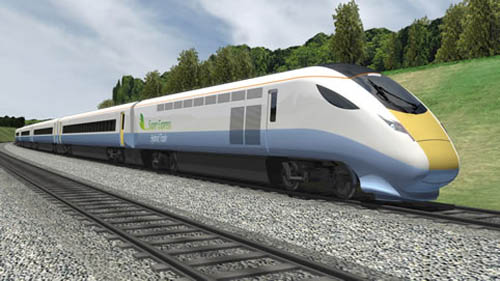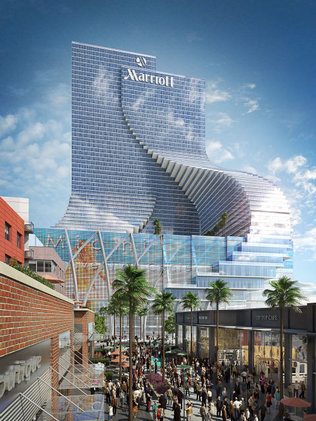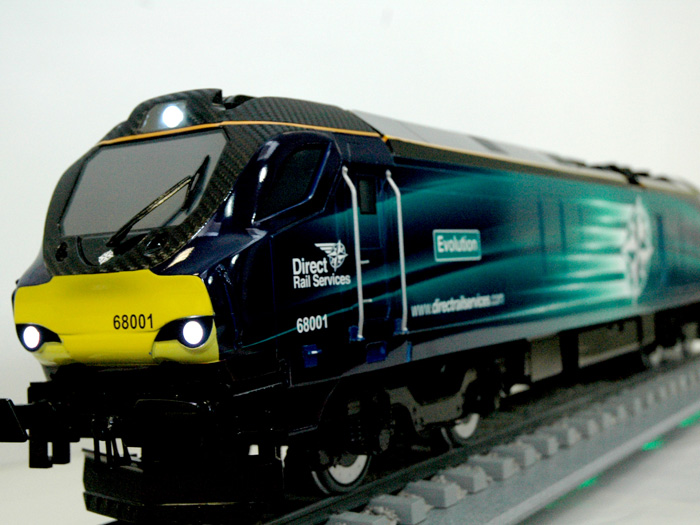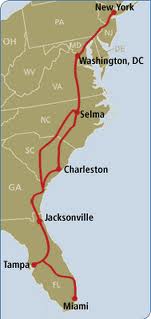 I saw on the twitter feeds of some transit/transport bloggers (twitter list) some interesting news about the ongoing All Aboard Florida project for a 3hr rail service between Miami and Orlando. They are seeking land for their Miami station complex:
I saw on the twitter feeds of some transit/transport bloggers (twitter list) some interesting news about the ongoing All Aboard Florida project for a 3hr rail service between Miami and Orlando. They are seeking land for their Miami station complex:
Managers for All Aboard Florida, the project to build an Orlando-to-Miami passenger train service, are about to begin negotiations with Miami’s Community Redevelopment Agency to acquire two parcels in downtown Miami as part of the plan to build a massive train station and transportation hub downtown.
...
He [Michael Reininger, president and chief development officer for the train project] said the two parcels are key to the project, as they are integral to the planned station and transport hub, a project he said will dramatically transform downtown Miami and Overtown, where project managers expect to create jobs and new opportunities for area residents and businesses. “We are not just developing these two blocks,” Reininger said. “In fact, we’re developing a very major infrastructure and development program that will be transformative for the entirety of downtown Miami.”
Besides building the Miami station for the Miami-Orlando train, Reininger said, All Aboard Florida is also planning a transportation hub that would provide links between the intercity train and the Miami-Dade transit services there such as Metrorail, Metromover and Metrobus.
And are also bidding for additional develoment on a neighboring site, which would crosslink the All Aboard Florida Station to the MDM proposals for a new Marriot at Miami Worldcenter:
The company that is planning to build a 3-hour rail link between Miami and Orlando recently responded to an RFP by the Overtown CRA for a plot of land near a station that they are planning to build in downtown Miami.
All Aboard Florida proposes to build office, retail and residential uses, including a 24-story tower on the overtown parcels. It would be linked to a new Marriott at Miami Worldcenter proposed by MDM, as well as the All Aboard Florida station.
The All Aboard Florida Rapid Rail project
Sunday Train discussed the All Aboard Florida Project about a year and a half ago, in Sunday Train: The Miami/Orlando Passenger Rail Project (Stars Hollow Gazette, 15 April, 2012). The coverage at that time remains a good capsule description of the project on most points:
Passenger train service between Miami and Orlando could begin as early as 2014 under a plan announced Thursday by Florida East Coast Industries.
The new "All Aboard Florida" service, which would be privately owned and operated, would offer frequent, regularly scheduled daily trains geared to business travelers and tourists. The Miami-Orlando trip by rail would take three hours, about the same time it takes by car via Florida's Turnpike.
There would be four stops: Miami, Fort Lauderdale, West Palm Beach and Orlando, each with connections to airports, seaports and existing rail systems such as Tri-Rail and Metrorail. The trains would run on existing FEC tracks that stretch along the east coast from Miami to Cocoa [Beach]. Forty miles of new track would link Cocoa to Orlando.
The revision to this is that completion is now slated for the end of 2015. However, given that All Aboard Florida is putting in a bid to acquire the parcels for the Miami station, the project is still quite clearly underway.
Additional details were given this week by Rusty Roberts, VP of corporate development, presenting on Tuesday to local Miami groups:
The trains will be less than 1,000 feet long, have two locomotives and seven passenger cars, and clear intersections in less than one minute, Mr. Roberts said. They'll offer hourly service starting around 6 a.m. with final departures at about 8 p.m., he said.
Based on rail curvature and other factors, he said, the trains will travel at speeds of up to 79 miles per hour between Miami and Palm Beach, accelerate to about 110 mph between Miami and Cocoa Beach, then reach speeds of about 125 mph when approaching Orlando. They will offer business- and coach-class services, Wi-Fi and gourmet meals.
... All Aboard Florida won't position itself as a commuter service, competing with Tri-Rail for residents traveling to work, he said. Instead, it plans to target the 94 million visitors who come to Orlando and Miami each year. One study found these visitors made about 50 million trips each year between Miami, Fort Lauderdale, West Palm Beach and Orlando.
What Is All Aboard Florida up to?
 A year and a half ago, I had two speculations as to what was behind this privately-funded passenger rail project ~ the first privately-funded passenger rail project in quite a long time. The first speculation was that this involved looking to make money through property development. The idea here is that Rapid Passenger Rail between appropriate end points three hours or less apart can be operated on a break-even basis. Therefore, if providing the service creates additional value for property at or near to stations along the route, the extra profit on those developments may well justify establishing and providing the service.
A year and a half ago, I had two speculations as to what was behind this privately-funded passenger rail project ~ the first privately-funded passenger rail project in quite a long time. The first speculation was that this involved looking to make money through property development. The idea here is that Rapid Passenger Rail between appropriate end points three hours or less apart can be operated on a break-even basis. Therefore, if providing the service creates additional value for property at or near to stations along the route, the extra profit on those developments may well justify establishing and providing the service.
The second speculation involved the expansion of the Panama Canal and works to increase the capacity of the Miami cargo port for the new, larger, "Panamax" container ships made possible by the expansion. The idea was that the passenger service might be bait to help the Florida East Coast regional freight railway to gain access to Class I freight lines near Orlando.
The two bids made public this week support the first speculation. The proposed station is far from just a train station, including not only cafeterias, restaurants and traveler oriented shops, but also offices, residences, and general retail. This would be leveraged if they are able to also attain the property between the Station and the Miami Worldcenter development, which would provide a direct interior pedestrian connection from the Worldcenter and its massive Marriott (illustrated) through to the train station. I have experienced this kind of connection, though at a smaller scale, in the upscale Queen Victoria Building shopping center in downtown Sydney, which connects at the basement level directly through to the Town Hall station, and in my experience it is quite effective. Making your way through interior walkways is much more pleasant than on sidewalk and pedestrain crosswalks ... especially with a rolling suitcase in tow.
The second speculation was not just wrong, but seems to be 180 degrees wrong. Rather than looking ahead to an increase in freight business, this project is about leveraging a freight rail corridor that is facing declining freight business. This was reported in November 2012, when All Aboard Florida bought land for its West Palm Beach station:
The report for All Aboard Florida, FECI’s name for its proposed service, describes adding a second track on 50 of the 66 miles between West Palm Beach and Miami and upgrading street crossings. Single tracks would remain on seven bridges, including two in Palm Beach County. A 40-mile section would be built to link Orlando with the FEC line in Cocoa.
The report proposes hourly trains making 16 to 19 trips per day and opening by 2015. It projects creating 1,200 construction jobs and 400 permanent jobs.
The first passenger trains on the line since 1968 would not conflict with freight movement because of double tracking and unified dispatch, the report said. It said the number of freight trains has fallen from 23 per day in 2006 to 10, a “permanent condition.
Since this is presently a single track line, there are no substantial infrastructure savings available from dropping down to ten freight trains from the previous twenty three. However, the FEC has long operated their freight trains at 90mph between West Palm Beach and Cocoa Beach, and a double track corridor has ample capacity for sixteen Rapid Rail trains operated at 110mph and ten freight trains operated at 90mph. It is not the contents of the trains that cause the major capacity problems when mixing freight and passenger rail, but the differences between the speeds, and there is little difference in transit speed between a 110mph passenger train with a few station stops and a 90mph non-stop freight.
Add in the fact that the dispatch of the trains will be performed by the FEC, which is owned by the same company that is establishing All Aboard Florida, and this is an effective way to leverage the existing rail infrastructure to generate more profit ... effective, that is, given the increase in property values that emerge from the regional train stations.
Also note that while All Aboard Florida is not requesting any capital funding or operating subsidies, they have applying for a Federal rail infrastructure loan, which became public knowledge when the loan application was submitted, but as All Aboard Florida is a private company, few details other than the fact of the application are available.
zOMG these aint REAL High Speed Trains!
I've already seen in newspaper article comments one reaction to the details of this project. To paraphrase, 'OMG this should be a bullet train! This is so slow! This is hardly any faster than driving!'.
This service would definitely attract more passengers with an 180mph or 220mph corridor than with a corridor with speed limits of 80mph, 110mph and 125mph. On the other hand, the faster corridor would easily be over $10b in cost, compared to the $1.5b that is project will cost. The difference in cost would be particularly substantial in this case, since the FEC owns a conventional rail corridor from Miami through to Cocoa Beach, which is already suited for 110mph passenger rail operations between West Palm Beach and Cocoa Beach, so the only new corridor required is from Cocoa Beach to Orlando. Rather than proceed with the expensive process of all new grade separations or upgraded level crossings for the existing corridor, which will be shared by both rail and freight, the approach that is likely the lowest cost way to hit their target of a 3hr trip from Miami to Orlando airport station, and also the approach with the least regulatory risk, is to build this new corridor as a completely grade-separated corridor dedicated to passenger rail operations.
The argument over whether these are High Speed Trains is a semantic argument. Define High Speed Trains as capable of 110mph or higher, and they are. Define High Speed Trains as capable of 150mph or higher, and they are not. That is why I call this class of service "Rapid Rail" ... to avoid this purely semantic argument.
As I have discussed, many times before, including about a year ago under the above title, the real world question is whether these services are likely to be effective transport option. And that seems highly likely. Depending on where their trip starts, this trip would be as fast or faster than driving for many prospective passengers. And many of the prospective passengers for these particular trips are travelers who have flown into Florida, so that driving involves the explicit cost of a rental car, rather than the implicit and easily neglected cost of driving their own car at home.
For those who would have flown instead, the majority of the air travel time for this kind of short hop is not in flight travel by getting to the origin airport, getting through airport security and getting out of the destination airport. If this were a bullet train, it would totally dominate air shuttles between Orlando and Miami, but even at three hours, it will be competitive for a substantial part of this business. This kind of trip is particularly appealing to business travelers, who can plug their laptop in and make far more effective use of their time enroute if traveling by train rather than either air or car, and, indeed, the projections are that about one fourth of the expected passenger demand will be for business travel.
As is so often the case, the answer to "is this fast enough" is not about headline maximum speed, but rather about the travel time and quality of the trip. Indeed, we might say that the California HSR system chose a bullet train system not because they were able to, but rather because they have to, since the LA Basin to the Bay Area by Rapid Rail would be five hours or more, and that is just too long a travel time to justify the expensive investment in getting the trains through the LA and SF urban areas as well as through the rough terrain between those two areas and the part of the Central Valley that lays between.
So the reason that the All Aboard Florida project seems viable as a private project seems threefold:
- The three hour travel time between Miami and Orlando (quicker for West Palm Beach and Fort Lauterdale);
- Possession of an efficient conventional rail corridor already designed for 110mph operation for over half its length, with spare transport capacity due to a drop in freight rail demand;
- The appeal of West Palm Beach, Fort Lauterdale and downtown Miami for real estate property development.
zOMG these will have TWO LOCOMOTIVES!
 One of the more amusing reactions to the information that came out this week came from Paul Druce, who I sometimes see commenting at the California HSR blog, tweeting under the "ReasonRail" handle:
One of the more amusing reactions to the information that came out this week came from Paul Druce, who I sometimes see commenting at the California HSR blog, tweeting under the "ReasonRail" handle:
That @AllAboardFla is planning on 2 locomotives +7 cars is a sad commentary on FRA regs and disadvantages of running diesel trains
— Paul Druce (@ReasonRail) August 22, 2013
For those who are not aware of what the term "locomotive" implies, there are two basic ways to design a passenger train. First, you can have the passenger cars hauled (and/or pushed) by a separate power car, or you can have some or all of the passenger cars act as power cars. The first is often called "loco-hauled", and the second is called "multiple unit" ~ either EMU for "electric multiple unit", or DMU for "diesel multiple unit.
So the inference that Paul Druce is drawing here is that All Aboard Florida has been forced to adopt a design with a diesel locomotive car at both ends, by FRA regulations. FRA regulations rely heavily on brute force crash resistance, and the end cars are required to have substantially more crash resistance than the cars in the middle of the train. Very few EMU or DMU passenger trains in Europe and Japan could be used on a conventional US rail corridor without substantial modification to the end cars, which would substantially increase their weight, reduce their energy efficiency, and by reducing power/weight ratios, slow down their performance accelerating from station.
However, far more is being drawn here from the mere mention of a two-locomotive design than is possibly warranted. The fact is that some fairly modern diesel Rapid Passenger Rail trains have adopted a "twin-headed" design. After all, putting a locomotive on each end rather than a locomotive on on one end and a driver-trailer on the other does not imply two equally heavy locomotives. Indeed, if a DMU design is more efficient than a design hauled by a single locomotive, because of the way that the motor wheels are distributed along the train, then for the same reason a twin-headed design with lighter weight locomotives on both ends may be superior to a loco-hauled design with a single, heavier locomotive on one end.
And if the locomotive is a modern design from overseas that has to be modified to meet FRA standard, its likely cheaper to buy pairs of lighter weight locomotives for each end than to buy a single locomotive for one end and a beefed up driver-trailer car for the other end, because the first order is buying a larger number of identical units.
We have no details on the design of the diesel locomotive for this train, which will operate up to 79mph between Miami and West Palm Beach, 110mph between West Palm Beach and Cocoa Beach, and 125mph between Cocoa Beach and Orlando. So it is evidently premature to jump to conclusions about how the train will perform versus one of the DMU designs that are more difficult to adapt to meet FRA standards.
However, there is no reason to believe that an FRA compliant twin-headed loco-hauled design is substantially inferior for this particular rail corridor than a non-compliant DMU would be.
What About Amtrak?
 The final issue I wanted to touch on was the issue of Amtrak operating trains on this corridor.
The final issue I wanted to touch on was the issue of Amtrak operating trains on this corridor.
The current generation of railcars being purchased by Amtrak are all compatible with 125mph operation, as are the locomotives being purchased for use in new regional services in Illinois and Michigan, Amtrack California and the Cascades Corridor in Washington/Oregon. Therefore, as long as an Amtrak service to Miami is equipped with the newer generation of locomotives and railcars, it would be able to operate on the All Aboard Florida corridor mixed in with All Aboard Florida services.
This would also offer a substantial speed upgrade in the Orlando/Miami leg of daily Silver Meteor Amtrak services to Miami, which is 5hr 45min. However, with nine stations served by between Orlando and the Miami terminus, operation on the All Aboard Florida would be much more of an express service than the Amtrak Silver Meteor.
All Aboard Florida has not commented on whether it would either permit or encourage Amtrak services to operate on their corridor. However, given their status as a project still seeking to buy station land and working toward breaking ground, I would not expect them to. After all, there has been substantial investment in Anti-Amtrak propaganda directed toward "Tea Party" Republicans, and so a pre-announced tie-in with Amtrak would cause additional resistance from that part of the political spectrum. At the same time, the same people who would be most in favor of Amtrak services operating along this corridor are likely to be generally well-disposed to this project in any event.
However, if the above observations regarding All Aboard Florida is correct ... if they are indeed looking to upgrading property values as the key profit center for this project ... then once they begin operation, there is no reason to expect them to be antagonistic to the operation of Amtrak services on their corridor.
The dramatic reduction in travel time from Orlando to Miami, combined with the opportunity to reach downtown Miami and the new Worldcenter complex, makes the prospect of being able to run on the All Aboard Florida corridor compelling. However, there are nine Amtrak stations between Orlando and its Miami terminus. It may make sense to operate a split service that divides in Orlando, with one part of the train running on the current, longer and slower, corridor, and the other part running on the All Aboard Florida corridor to provide an express to Miami. Alternatively, if All Aboard Florida completes their mooted second phase extension to Jacksonville, an even better upgrade in service from Georgia and the Carolinas through to Miami would be offered by splitting the Amtrak train at Jacksonville.
If operating onto the All Aboard Florida corridor is not practical, an alternative approach is to bring one or more of the All Aboard Florida services to the Amtrak, taking a train that will normally terminate at Orlando airport, and operating it from the airport onto the Sunrail local rail corridor to the Orlando Amtrak station. As the Orlando Amtrak station is also a Sunrail station, this would also improve connections to the All Aboard Florida corridor from the sixteen other planned Sunrail stations along the two phases of the Sunrail local rail corridor.
Whatever connection is finally arrived at, I wouldn't expect to begin hearing any details until, at the earliest, when the project has finished acquiring the land for all of its stations and has broken ground on building its corridor. And it would not be at all surprising if serious work on interconnecting with Amtrak waits until after the ribbon on the Miami/Orlando part of the project has been cut and passenger service has commenced.
Conversations, Considerations and Contemplations
As always, rather looking for some overarching conclusion, I now open the floor to the comments of those reading.
If you have an issue on some other area of sustainable transport or sustainable energy production, please feel free to start a new main comment. To avoid confusing me, given my tendency to filter comments through the topic of this week's Sunday Train, feel free to use the shorthand "NT:" in the subject line when introducing this kind of new topic.
And if you have a topic in sustainable transport or energy that you want me to take a look at in the coming month, be sure to include that as well.
Comments
I say, see the silence of the ribbons of iron and steel